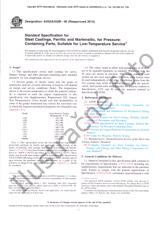Potrebujeme váš súhlas na využitie jednotlivých dát, aby sa vám okrem iného mohli ukazovať informácie týkajúce sa vašich záujmov. Súhlas udelíte kliknutím na tlačidlo „OK“.
ASTM E3249-21
Standard Guide for Remedial Action Resiliency to Climate Impacts
NORMA vydaná dňa 15.4.2021
Informácie o norme:
Označenie normy: ASTM E3249-21
Poznámka: NEPLATNÁ
Dátum vydania normy: 15.4.2021
Kód tovaru: NS-1025339
Počet strán: 14
Približná hmotnosť: 42 g (0.09 libier)
Krajina: Americká technická norma
Kategória: Technické normy ASTM
Kategórie - podobné normy:
Anotácia textu normy ASTM E3249-21 :
Keywords:
chemicals of concern, climate change, ecosystem services, environmental justice, extreme weather, remediation, site clean up, superfund,, ICS Number Code 13.020.99 (Other standards related to environmental protection)
Doplňujúce informácie
| Significance and Use |
|
4.1?This guide outlines various techniques for evaluating and mitigating the impacts of climate change and weather extremes on remediation systems, activity and use limitations, stewardship and remediation activities. 4.2?Users include: local, state, federal, tribal, and international agencies; the military; environmental consultants; developers; financial institutions; non-governmental organizations; environmental advocacy groups; commercial businesses, industries, and the interested public. 4.3?A 2018 ITRC survey of 45 state environmental agencies found key Best Management Practices (BMPs) and adaptation strategies for resilient cleanup. These include remedy infrastructure and disaster planning for chemical releases as an important part of the states clean-up program. In some cases, such considerations are now required by state regulations and included in policy and guidance (ITRC, 2018 4.4?Adaptation is important because it is about considering and addressing the changing frequency and intensity of extreme events. Adaptation differs from resiliency by anticipating, planning and preparing for impacts under both current and future climate conditions. 4.5?There are many models and different strategies on adapting to climate and weather extremes, including those in the European Union (European Union, 2013 (4), IPPC, 2001 (5)). 4.6?The USGAO has reported benefits from evaluating climate risks for large projects. (USGAO, 2019 4.7 Companies and organizations operating in accordance with ISO 14001-2015 may find this guide useful for meeting the long-term compliance obligation requirements of Clause 5.2 (ISO 14001-2015) 4.8?This guide should be integrated into the fundamentals of an organizations management system in order to support an organizations strategies, plans, and operations. For example, ISO, Risk, or Conformity Assessment references may influence integrating risk management into significant activities and functions. ((ISO 14001-2015)) 4.9?Users also include: owners of Superfund sites; oil, gas and chemical companies; owners of land upon which oil, gas and chemical companies operate; design/build consultants and other industrial users who can include principles of this standard into their design and operation procedures and risk evaluation protocols. These are well -recognized management control programs within the chemical industry, and as such are highly relevant to how companies manage the resilience of physical systems. (ACC, 2014 4.10?Climate factors discussed in this standard guide can result in the unplanned or unexpected release of chemicals of concern into the environment. These releases may adversely affect human and ecological receptors and impact cultural resources and infrastructure. |
| 1. Scope |
|
1.1?The potential for increasing climate and extreme weather impacts requires more attention be given to their effect on sites where chemicals have been released. All stages of remediation planning and implementation should consider and address potential climate and extreme weather impacts, such as flooding and wildfires, that may affect remedy sustainability, continued protection of human and ecological receptors, the surrounding community, and the environment. Both resiliency to current extreme weather impacts as well as adaptation to longer-term impacts due to the changing climate should be considered. Consideration of climate and extreme weather impacts during stabilization, remedial investigation, feasibility studies, remedial design, remedial action implementation, long-term operations and management, and site stewardship may lead to the use of innovative technologies and more robust remediation strategies. 1.2?The conceptual site model is designed to inform all aspects of site decision making, inclusive of the investigation, feasibility study, design and implementation. It may be the most important mechanism to integrate consideration of climate impacts. The conceptual site model should be continuously developed and refined, while considering new knowledge about climate factors and potential impacts to the site. 1.3?This ASTM resiliency guide identifies the best management practices for incorporating resiliency and vulnerability assessment into all stages of the site cleanup process. Historically, resiliency was primarily considered or contemplated in the final stages of the cleanup process, such as in the operation and maintenance stage, after a remedy was completely in place at a site. Gradually, resiliency has extended to earlier stages of the cleanup process. This may include initial vulnerability assessment for site stabilization and extending into the remedial investigation and feasibility stage. This guide will enable site project managers and others involved in site clean up to incorporate resiliency more robustly into the early stages of the cleanup process, and thereby improve resilience to current potential impacts as well as prepare for anticipated future impacts due to the changing climate. 1.4 The scope of this guide is generally based upon experience in site management in the US, however it may also apply to sites in other countries, regions and continents. 1.5?This international standard was developed in accordance with internationally recognized principles on standardization established in the Decision on Principles for the Development of International Standards, Guides and Recommendations issued by the World Trade Organization Technical Barriers to Trade (TBT) Committee. |
Odporúčame:
Aktualizácia technických noriem
Chcete mať istotu, že používate len platné technické normy?
Ponúkame Vám riešenie, ktoré Vám zaistí mesačný prehľad o aktuálnosti noriem, ktoré používate.
Chcete vedieť viac informácií ? Pozrite sa na túto stránku.




 Cookies
Cookies
